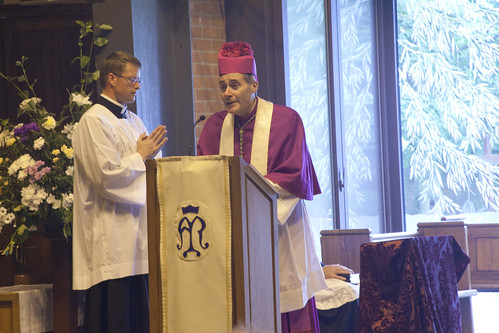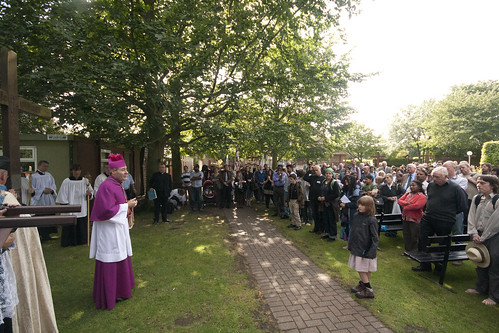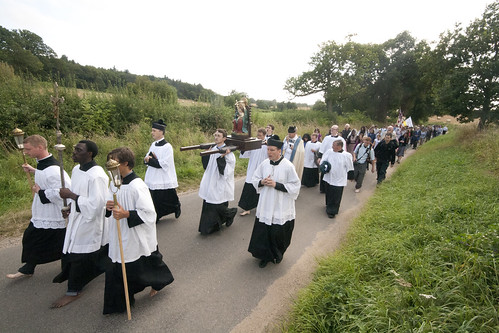
Our old friends at The Tablet have attempted to portray Bishop Davies' sermon at the LMS Pilgrimage to Walsingham as a sort of call to us to maintain, or even adopt, the orthodoxy represented by the Second Vatican Council:
'The Bishop of Shrewsbury, Mark Davies, has called on the Latin Mass Society (LMS) to pass on the faith according to the Second Vatican Council, writes Sam Adams.' (Tablet, 1st Sept, p30)
Well we have news for Sam Adams: the truth is more interesting. Bishop Davies explores, at the end of his sermon, what exactly the Council was supposed to be about, and stresses that 'we' - fellow pilgrims to Walsingham - must keep that in mind, and by implication not heed the 'hermeneutic of rupture', the claim that the Council justified every kind of rejection of tradition. Rather, the Council was intended to pass on the Faith - the Faith of the Church, preserved by Tradition - in its integrity. The idea that Bl. Pope John XXIII, whose face (with tiara) adorns every edition of The Tablet in an advert for the ludicrous group 'Catholics for Vatican II', would have wanted to jettison whole planks of the faith, or major parts of the ancient liturgy, is absurd, and completely incompatible both his words and with what we know of him as a man.
Bishop Davies' call for us to do what Bl. Pope John XXIII wanted, that is, to pass on the Faith in its fullness, in ways best adapted to reach the people of our day as effectively as possible, is one readily accepted by the Latin Mass Society and all traditionalists. On the 15th of this month I will be publishing a Position Paper on the Extraordinary Form and Western Culture, which explores exactly how the ancient Mass is suited to aid the evangelisation of the post-Christian culture in which we find ourselves.
The full text of Bishop Davies' sermon is on his diocese's website. Since it is not long, I reproduce it here with added emphases.

“When England returns to Walsingham Our Lady will return to England,” under the title of those words of Pope Leo XIII, which have inspired this pilgrimage, you have returned to Walsingham today. Returned like the solitary leper in the Gospel today to “give glory to God” for the gift of the Catholic faith we share, for the grace of all the Sacraments which have brought us a cleansing and new life infinitely more wonderful than the healing of those ten lepers, and above all for this Most Blessed Sacrament of the Eucharist. At the centre of “England’s Nazareth” built to recall the joy of the angelic salutation, the very joy of the Incarnation was not a statue but always an Altar. The scholar Erasmus provides us with a description of the Holy House on the eve of the Shrine’s destruction: “panelled with wood, having little light but that of the tapers,” he wrote “and glistening within with the reflection of gold, silver and precious stones. Inside, there was altar, usually with a Canon in attendance, and the figure of Our Lady stood at the right end of the altar in a dark corner.” The light which was extinguished here in Walsingham was not only England’s renowned devotion to Our Lady but the light of that flame which pointed night and day to the Real Presence of Our Lord, truly God and Man, in the Blessed Sacrament of the Eucharist. So it is with a renewed devotion to the Mother of God and our Mother too that we return here with thankful hearts to the Altar of God where the joy of the Church’s youth is ever renewed (Antiphon for Psalm 42).

Even on a Holiday Weekend it is hard for us now to imagine the number of pilgrims who once came along these pathways to Walsingham. The East London site of the Olympic Games has briefly been the focus of global attention, filled with hundreds of thousands of athletes and visitors and will soon stand strangely empty? Walsingham was once the focus of world attention and not just for a fortnight but across the course of centuries. So many came to this remote corner of Norfolk it was lyrically suggested the constellation of the stars pointed the way to Walsingham! Yet those who come for the first time to England’s National Shrine quickly realise they have come to somewhere that was left in ruins! The tiny chapel, the slipper chapel is all that now remains of England’s “Nazareth,” a centre of pilgrimage once renowned alongside Jerusalem and Rome. The ferocity of its destruction, its rapid passing from memory would cause a ballad to lament, “Walsingham is no more!” Yet Walsingham has once again become a place of pilgrimage and hundreds of thousands have returned.
These very ruins of Walsingham towards which you will walk the last “Holy Mile” of this Pilgrimage serve to remind us that each successive generation must make that choice for the faith again. Much as we saw a flame, which was only a flame, passing from hand to hand across the country so something greater “the flame of faith” must be passed on from generation to generation. In October this year our Holy Father Pope Benedict invites us to celebrate a “Year of Faith,” fifty years after the solemn opening of the Second Vatican Council. The central aim of the Council was this transmission of the Church’s faith amid the new and rapidly changing conditions of our time. “The greatest concern of the Ecumenical Council” Blessed John XXIII declared on that October day, “is this, that the sacred deposit of Christian doctrine should be guarded and taught more efficaciously” (Address at the Opening of the Second Vatican Council 11th October 1962). In his Apostolic Letter Porta Fidei Pope Benedict invites us to celebrate both the opening of the Council and the publication twenty years ago of “The Catechism of the Catholic Church” as its authentic fruit. “We want this Year to arouse in every believer,” the Holy Father writes “the aspiration to profess the faith in fullness and with a renewed conviction, with confidence and hope. It will also be a good opportunity to intensify the celebration of the faith in the liturgy, especially in the Eucharist, which is (as the Council taught in Sacrosanctum Concilium 10) “the summit towards which the activity of the Church is directed … and also the source from which all its power flows” (Porta Fidei 9).

As the Latin Mass Society, as the faithful attached to the Extraordinary Form of the Roman Rite, as pilgrims to Walsingham we accept together with enthusiasm the call of the Second Vatican Council in all its authentic teaching and the invitation of this “Year of Faith” to which the Holy Father calls the whole Church. In this way we must seek not only to guard the deposit of faith but teach it more effectively, intensify the celebration of the faith in the Sacred Liturgy and bear witness to this faith in our whole lives. In this way we will pass on the flame of faith and so leave to new generations not the ruins of a Christian past but the faith which Walsingham has represented for almost a thousand years: the joy of the angelic salutation, the joy of the Word made flesh, the joy of the Blessed Sacrament of the Altar which Our Lady desired should never be lost in this land
Pray for us, O Most Holy Mother of God,
that we may be made worthy of the promises of Christ.
"The idea that Bl. Pope John XXIII, whose face (with tiara) adorns every edition of The Tablet in an advert for the ludicrous group 'Catholics for Vatican II', would have wanted to jettison whole planks of the faith, or major parts of the ancient liturgy, is absurd, and completely incompatible both his words and with what we know of him as a man."
ReplyDeleteHear, hear!
I recently found a forgotten article by Cardinal Heenan, written on the first anniversary of Pope John's death. It basically says this exact same thing. I hope to republish it sometime soon!